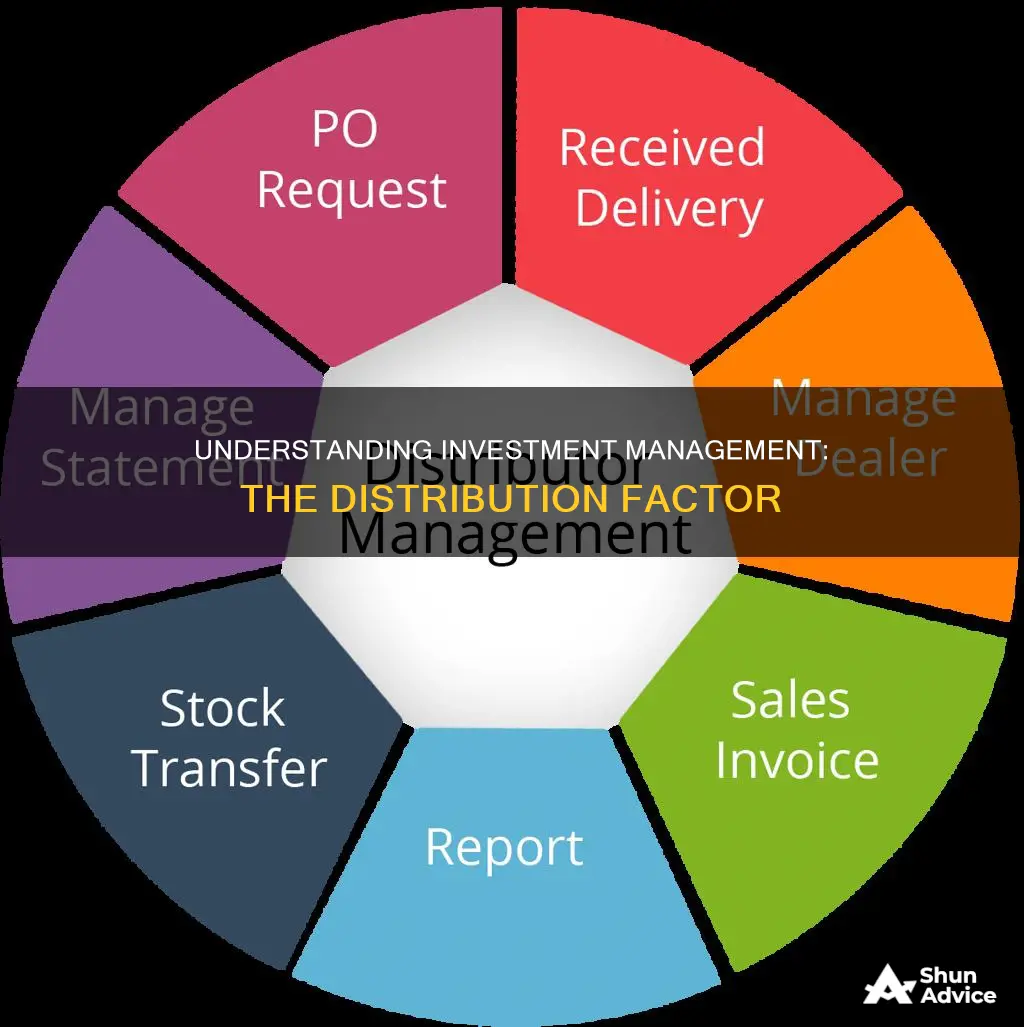
Distribution in investment management refers to the disbursement of assets from a fund, account, or individual security to an investor or beneficiary. This can include mutual fund distributions, which are required by law to pass profits back to investors or shareholders, and retirement account distributions, which are mandatory withdrawals once the account holder reaches a certain age. Distributions can also refer to the sale of large blocks of securities by institutions, which is done gradually to avoid depressing prices.
| Characteristics | Values |
|---|---|
| Definition | In the context of investment management, distribution refers to the disbursement of assets from a fund, account, or individual security to an investor or beneficiary. |
| Types | There are several types of distributions, including mutual fund distributions, securities distributions, and retirement account distributions. |
| Frequency | Distributions can be made on a regular basis, such as monthly, quarterly, or annually. |
| Form | Distributions are typically given in the form of cash, but can also be in the form of stock, physical product, or other property. |
| Taxation | Distributions are generally taxable, unless they are from a tax-free fund. The taxation of distributions depends on the type of distribution and the individual's tax bracket at the time of withdrawal. |
| Timing | Distributions can occur at any time, but some types of distributions, such as retirement account distributions, are subject to age restrictions and may have tax implications if withdrawn early. |
| Impact on Fund Price | When a fund issues a distribution, its price or net asset value (NAV) typically drops accordingly. |
| Investment Returns | Distributions can be a way for companies to return profits to shareholders, and for investors to benefit from investment returns. |
| Private Equity Funds | In the context of private equity funds, distributions are paid when fund managers realise their investments in underlying companies or assets. |
What You'll Learn

Mutual fund distributions
In the financial world, the term "distribution" generally refers to the disbursement of assets from a fund, account, or individual security to an investor. Mutual fund distributions, specifically, consist of net capital gains made from the profitable sale of assets in a portfolio, as well as dividend income and interest earned by those assets.
Mutual funds can realise net capital gains when they receive dividends or interest from the assets they hold and make profitable sales of portfolio assets. The fund can then return these gains to investors in the form of dividends and distributions. Mutual funds are required by law to pay out these capital gains and income to the funds' shareholders.
When a mutual fund issues a distribution, the shareholder can choose to be paid directly, putting the money into their account, or they can elect to buy more shares of the fund, known as reinvesting. If the shareholder chooses to reinvest, the dollar amount of their investment in the fund will increase by the distribution amount.
It is important to note that mutual fund distributions may not always be beneficial. While a rising NAV is a positive sign, the distribution may reflect gains built up over time that are only now being realised. Therefore, it is recommended to focus on changes in the fund's NAV and how those changes compare to the fund's benchmark.
Strategic Portfolio Weighting: Key Factors for Investment Success
You may want to see also

Public company distributions
In the context of investment management, the term "distribution" refers to the payment of assets from a fund, account, or individual security to an investor or beneficiary. This can include retirement account distributions, mutual fund distributions, and stock and bond distributions.
Publicly traded companies can make distributions to their shareholders in the form of interest or by returning capital. Shareholders can receive distributions on a regular basis, such as monthly, quarterly, or annually. These distributions are typically treated as income and must be reported to the IRS.
There are a few key differences between distributions and dividends. Dividends are rewards paid to shareholders for their investment in a company's equity, usually from the company's net profits. The frequency and payout rate of dividends are determined by the board of directors. On the other hand, distributions are common for S Corporations, and sometimes partnerships or LLCs make distributions as well. Distributions are typically given in the form of cash, while dividends can be paid as cash, shares of stock, or other property. Additionally, distribution amounts tend to be higher than dividends.
LLCs, or Limited Liability Companies, can make distributions by paying out a portion of their capital directly to their members, who are also the business owners. The allocation of distributions among LLC members is usually outlined in the LLC operating agreement and is typically based on their ownership percentage or membership interest. LLC distributions can serve as a replacement for a traditional salary, providing more flexibility for the members and the company.
FDI vs Portfolio Investment: Understanding the Key Differences
You may want to see also

Retirement account distributions
- Distributions before the age of 59 and a half: These distributions are subject to an IRS penalty and ordinary income tax. This is because the funds were untaxed when deposited into the account.
- Distributions during or after the individual reaches the age of 59 and a half: While these distributions are not subject to the penalty, taxpayers will still pay tax on the sums withdrawn at their current tax bracket.
Other retirement accounts also have age limitations for withdrawals without penalties. For example, except for the Roth IRA, all retirement plans mentioned above require the holder to begin withdrawing funds once they reach the age of 73 if they were born between 1951 and 1959, or 75 if they were born in 1960 or after. These are known as Required Minimum Distributions (RMDs). The exact amount of this annual RMD depends on the account holder's age and the value of the funds in the account, as per IRS guidelines.
All distributions from these retirement accounts are taxed based on the individual's tax bracket at the time of withdrawal. This is because contributions to the account were made with pre-tax dollars. Only distributions from Roth IRAs or Roth 401(k)s can be taken without income tax being due, as contributions are made with after-tax dollars.
Actuaries: Investment Portfolio Management, a Necessary Skill?
You may want to see also

Private equity fund distributions
In the financial world, the term "distribution" generally refers to the disbursement of assets from a fund, account, or individual security to an investor. This can include retirement account distributions, mutual fund distributions, and dividend distributions.
Distributions in private equity are paid out when fund managers realise their investments in underlying companies or assets. Typically, some capital starts flowing back to investors within the first 1.5 to 4 years, with larger distributions following later in the fund's life. The fund's lifecycle follows distinct stages, including sourcing opportunities, executing a value creation plan, and then selling or "harvesting" the investments.
The distribution waterfall structure is a key concept in understanding private equity distributions. It outlines the order of priority for distributing profits and revenues between fund investors and managers. The structure typically consists of three stages: the preferred return stage, the general partner catch-up stage, and the remaining distributions stage.
In the preferred return stage, investors receive returns up to a predetermined percentage, typically around 8%. This stage ensures that fund managers achieve a baseline return for investors before collecting incentive compensation. The general partner catch-up stage allows the fund manager to receive a larger share of profits once certain conditions are met, such as returning contributed capital and reaching the preferred return. The remaining distributions stage involves returning distributions to limited partners until all investments are liquidated and distributions are made to all relevant parties.
The timing and size of distributions are critical in private equity. Factors influencing the size of distributions include institutional investor participation, accounting and distribution policies, fund size, revenue growth, profit margins, and valuation multiples. Distribution triggers refer to the events or conditions that determine when and how distributions are made, such as the fund reaching a certain level of profitability or the completion of an exit or sale of portfolio investments.
Understanding the intricacies of private equity distributions is crucial for investors to maximise returns and minimise risks. By comprehending the distribution waterfall structure, the different stages, and the factors influencing timing and size, investors can make informed decisions and optimise their investment strategies.
Retirement Investments: Strategies for Effective Money Management
You may want to see also

Distribution stock
When larger institutions sell off shares, this is known as distribution stock. This is distinct from an individual trader selling stock, as large institutions must manage the dynamic of distribution to avoid a precipitous drop in stock prices. For example, a portfolio manager of an investment fund cannot simply place a single order to sell a large block of shares, as this would quickly absorb all current buy orders at the market price, and market makers would begin adjusting market prices to find more buyers, causing the price to drop. To avoid this, the portfolio manager must offer the shares in smaller chunks throughout the day or over several days.
A distribution day occurs when major market indexes fall by 0.2% or more on volume that is greater than the previous trading day. A string of these days together is called distribution days and is often associated with signs of a market top.
Strategies to Optimize Your Investment Portfolio Performance
You may want to see also
Frequently asked questions
Distribution in investment management refers to the disbursement of assets from a fund, account, or individual security to an investor or beneficiary. This can include mutual fund distributions, public company distributions, and retirement account distributions.
There are three main types of distributions: mutual fund distributions, securities distributions, and retirement account distributions. Mutual fund distributions occur when a mutual fund distributes capital gains, dividends, or interest income to fund owners. Securities distributions involve the payment of interest, principal, or dividends by the issuer of the security to investors. Retirement account distributions are mandatory withdrawals after the account holder reaches a certain age.
Distributions can come from various financial products, but they typically go directly to the beneficiary electronically or by check. In the case of mutual funds, distributions are made from the fund's assets, which causes a decrease in the fund's net asset value and, consequently, its price.
Both distributions and dividends involve payments to shareholders, but they have distinct characteristics. Distributions are allocations of capital and income throughout the calendar year and are typically given in the form of cash. Dividends, on the other hand, are rewards paid to shareholders for their investment in a company's equity, usually from the company's net profits.







